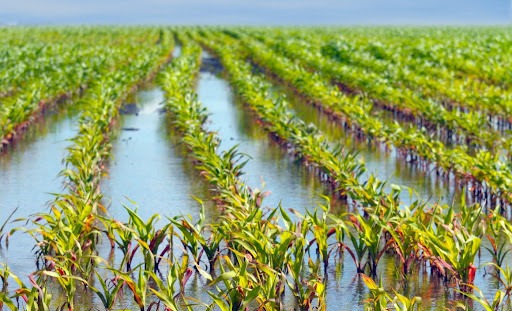By Roseline Okakah
In recent times, devastating floods have swept across parts of Nigeria, once again revealing the nation’s vulnerability to seasonal climate shocks and posing a serious threat to food security and rural livelihoods.
Recently in Mokwa Local Government Area of Niger State, more than 200 lives were lost and over 3,000 residents displaced following heavy floods that submerged farmlands and destroyed infrastructure.
This tragedy adds to a series of catastrophic flooding events that have occurred in recent years. In September 2024, floods in Borno State killed 230 people and displaced over 600,000. Earlier in 2022, flooding across 34 of Nigeria’s 36 states claimed hundreds of lives and displaced more than 1.3 million people.
In 2022, the release of the Lagdo Dam in Cameroon killed over 600 people, displaced 1.3 million, and destroyed over 100,000 hectares of farmland in Benue and other states.
Exacerbation of Food Insecurity
In addition to its negative impact on lives and property, flooding remains one of the most pressing environmental threats to Nigeria’s agriculture-based economy, exacerbating food insecurity in the country.
It destroys crops, washes away nutrient-rich topsoil, and damages vital infrastructure, including irrigation systems, storage facilities, and rural roads.
With agriculture employing over 70% of Nigeria’s rural population, the effects of these disasters on the economy are severe and far-reaching.
Livestock losses are also common during floods, further reducing farmers’ income and depriving communities of essential protein sources.
Nigeria’s heavy reliance on rain-fed agriculture makes the sector particularly vulnerable to erratic rainfall and excessive flooding, leading to harvest disruptions, lower yields, and food shortages.
These impacts extend beyond farming communities. Every flood season brings increased food prices and strained food supplies for millions of Nigerians.
In 2023, though the number of lives lost was lower than in previous years, floods across key agricultural zones still caused widespread destruction. Farmlands near major rivers and their tributaries, especially in major food-producing states, were badly affected.
The recent flood in Mokwa, a vital agricultural zone, has had a devastating impact on the sector. Large tracts of rice, beans, and onion farmlands were submerged. Irrigation systems were damaged, and some fields remained underwater days after the flood.
Data from the National Emergency Management Agency (NEMA) revealed that over 180,000 farms were affected by floods in 2024.
In its 2024 report, the Food and Agriculture Organization (FAO) noted that floods in 29 states displaced thousands, destroyed vast farmlands, and affected more than 2.5 million people as of early September.
According to FAO, approximately 200,000 people were displaced, and 1.3 million hectares of land, including 558,000 hectares of cropland, were submerged.
Flooding worsened by climate change has consistently hit Nigeria’s agricultural sector, which contributes 30% to GDP and employs over 70% of the workforce. In 2022, maize and rice production dropped by 12% and 21%, respectively, intensifying food insecurity.
Taming the Menace
To address this challenge, a holistic and environmentally conscious approach to flood management is essential.
Key strategies include sustainable land use planning within river basins, upgrading urban drainage infrastructure, and restoring natural floodplains to enhance water absorption and reduce overflow.
For instance, urban drainage and water management done in Kampala, Uganda, includes expanded drainage channels and regular desilting to prevent clogging. Nigeria can replicate this with state-level master plans for flood-prone cities like Lokoja and Minna.
Early warning systems can also be adopted. The Nigerian Meteorological Agency (NiMET) and National Emergency Management Agency (NEMA) can scale up public awareness campaigns, including using SMS alerts in local languages and community radio to broadcast warnings to residents of impending floods.
On the farm level, climate-resilient techniques such as deep-bed farming practised in Malawi and the adoption of floating rice varieties developed by the African Rice Center and the International Rice Research Institute (IRRI) could help farmers in flood-prone regions adapt. Diversified cropping systems and improved extension services are also being recommended.
Another strategy that can be employed in combating floods in Nigeria is wetland restoration and river management. This can be done to restore and redesign landscapes to absorb excess water naturally. Nigeria can adopt this in the Niger-Benue confluence area to reduce overflow risk.
Lastly, farmers should adopt insurance and risk financing. Nigerian Agricultural Insurance Corporation (NAIC) policies should be made affordable and accessible to rural farmers.
These strategies can help to reduce the impact of flooding in areas prone to flooding in Nigeria, make communities better prepared and respond swiftly to impending flood threats and also regulate natural water flow. These solutions, if properly implemented, can form a holistic approach that will not only reduce the damage caused by floods but also protect lives, properties and ecosystems across the country.









